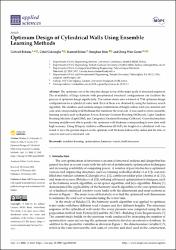Optimum design of cylindrical walls using ensemble learning methods
Künye
The optimum cost of the structure design is one of the major goals of structural engineers. The availability of large datasets with preoptimized structural configurations can facilitate the process of optimum design significantly. The current study uses a dataset of 7744 optimum design configurations for a cylindrical water tank. Each of them was obtained by using the harmony search algorithm. The database used contains unique combinations of height, radius, total cost, material unit cost, and corresponding wall thickness that minimize the total cost. It was used to create ensemble learning models such as Random Forest, Extreme Gradient Boosting (XGBoost), Light Gradient Boosting Machine (LightGBM), and Categorical Gradient Boosting (CatBoost). Generated machine learning models were able to predict the optimum wall thickness corresponding to new data with high accuracy. Using SHapely Additive exPlanations (SHAP), the height of a cylindrical wall was found to have the greatest impact on the optimum wall thickness followed by radius and the ratio of concrete unit cost to steel unit cost.Özet
The optimum cost of the structure design is one of the major goals of structural engineers. The availability of large datasets with preoptimized structural configurations can facilitate the process of optimum design significantly. The current study uses a dataset of 7744 optimum design configurations for a cylindrical water tank. Each of them was obtained by using the harmony search algorithm. The database used contains unique combinations of height, radius, total cost, material unit cost, and corresponding wall thickness that minimize the total cost. It was used to create ensemble learning models such as Random Forest, Extreme Gradient Boosting (XGBoost), Light Gradient Boosting Machine (LightGBM), and Categorical Gradient Boosting (CatBoost). Generated machine learning models were able to predict the optimum wall thickness corresponding to new data with high accuracy. Using SHapely Additive exPlanations (SHAP), the height of a cylindrical wall was found to have the greatest impact on the optimum wall thickness followed by radius and the ratio of concrete unit cost to steel unit cost.

















